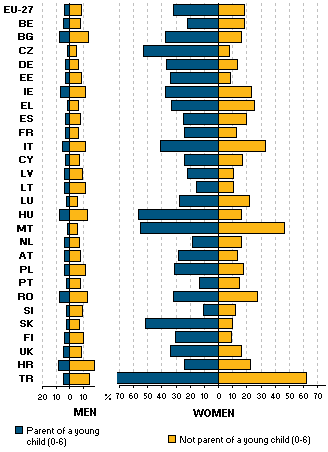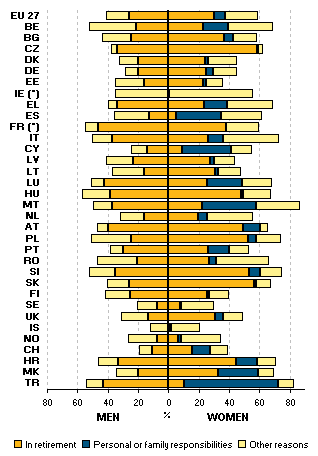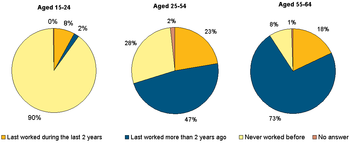Archive:People outside the labour force
- Data from October 2010, most recent data: Further Eurostat information, Main tables and Database.
This article analyses labour market participation in the European Union (EU), broken down by sex and age, on the basis of the results of the EU Labour force survey (EU-LFS). In 2010, the number of inactive persons as a percentage of the working age population in the EU-27 reached a new low of 29.0%, continuing the downward trend of the previous years. This positive development is largely due to the increased participation of women in the labour market. The economically inactive population remains a heterogeneous group, e.g. as regards age, reasons for inactivity and the level of attachment to the labour market.






Main statistical findings
Fewer people outside the labour force in 2010 - increased female participation in the labour market
This statistical article analyses the economically inactive population, i.e. the population that is neither employed nor unemployed. Since 2000 the share of the inactive population in the total population of working age[1] has fallen from 31.4% to 29.0% in the EU-27. This corresponds to a reduction of 4.5 million inactive persons. The 2010 result confirms the downward trend in the population outside the labour market in spite of the economic crisis. The effects of the crisis are visible nevertheless: whereas the yearly decrease of the inactivity rate used to be -0.3 percentage points (pp) on average during the period 2003-2008, the ratio decreased by only 0.1 point in 2009 and 2010. The crisis has affected people differently depending on their sex and age. While in 2010 the inactivity rate of women aged 25-64 maintained the downward trend seen in previous years, the inactivity rate among men aged 25-64 rose (+0.1pp) for the second year in a raw. Young adults aged 15-24 are affected even more (+0.7pp in 2010).
Almost all of the decline in inactivity rates since 2000 is due to the rising participation of women in the labour force. The share of women outside the labour market fell during that period from 39.9% to 35.6%, while the share of men outside the labour force remained almost stable, falling slightly from 22.9% in 2000 to 22.4% in 2010.
In all Member States women are more likely than men to be outside the labour force. In the Nordic and Baltic countries the gender gap was 7 percentage points or less in 2010, while in Malta, Italy and Greece the difference was more than 20 percentage points. The extreme cases are Lithuania, where the gender difference is only 3.6 percentage points, and Malta, where it reaches 35.4 percentage points.
Persons with lower education are more likely to be inactive
As was seen above, the incidence of inactivity in the labour market is very gender-specific. Another determining factor is the educational level attained.
Persons attaining a low educational level are more likely to be inactive. In 2010 and for the whole EU-27, the inactivity rate of persons in the age group 25-64 who had attained a low educational level (i.e. less than lower secondary) was 37.3%, as compared to 20.8% for persons with a medium educational level (at least lower secondary level, but less than tertiary) and 11.8% for persons with a high (i.e. tertiary) level.
This means that the likelihood of staying out of the labour market is more than 3 times greater for the poorly educated than for highly-educated people. Young persons aged 15-24 are omitted from this comparison as many of them are still in education.
This relationship between education and inactivity applies irrespective of sex and age. While inactivity rates are very different for men and women and between the age groups 25-54 or 55-64, within each combination of these variables those with lower education have a greater likelihood of being out of the labour market.
Young adults in education
Persons aged 15-24 tend not to be in the labour force: in 2010, 56.8% of young men and women in that age category in the EU-27 were inactive, making a total of 33.3 million persons. The rate of inactivity in this age group ranges from 31% in the Netherlands and 32.6% in Denmark to 75.1% in Hungary and 73.4% in Luxembourg. Differences between countries are largely explained by the number of students having or seeking a job (as they are then classified as employed or unemployed instead of inactive persons, even if the job is a minor one).
The incidence of and reasons for inactivity of men and women in this age group 15-24 do not reveal gender differences comparable to those observed in older age groups. Being in education is the main reason that both sexes give for inactivity, but young women are more likely to be inactive for this reason than men (43.3% and 40.9% respectively in the EU- 27 in 2010). The biggest gender-related difference in this age group is that 3.5% of women report family responsibilities as their main reason for not looking for a job, while for young men this is extremely rarely the case. Exceptionally, in Turkey a majority of inactive women aged 15-24 report family or personal responsibilities as the main reason for inactivity.
Family responsibilities main cause of inactivity of women aged 25-54
The prime working age in the EU is between 25 and 54 years. This is also the age when families are started and children are raised. It is in this age group that the gender differences of the inactivity rate are more pronounced. In 2010, 8.3% of men in this age group were inactive in the EU-27 compared to 21.9% of women. In absolute numbers this amounted to about 8.8 million men and 23.1 million women. The inactivity rate of men was lowest in the Czech Republic (4.5%), Luxembourg (5.3%) and Malta (5.7%) and highest in Bulgaria (13.7%), Hungary (12.8%) and Romania (12.5%). The inactivity rates of women aged 25-54 ranged in 2010 from 13.0% or less in Slovenia, Lithuania and Sweden to 49.1% in Malta and 35.6% in Italy. Turkey recorded 66.6% of women aged 25-54 being outside the labour market.
In the EU-27, 9.6% of the women aged 25-54 (i.e. almost half of the total of 21.9% of inactive women), are inactive for personal or family reasons, whereas only 0.5% of men give this as the main reason. The EU-LFS only collects the main reason although other reasons might exist.
Aside from personal or family responsibilities, the differences between the genders are minimal. Approximately the same number of men and women in this age category are inactive due to sickness/disability, education or retirement: 4.9 million men and 5.0 million women (respectively, 55.8% and 21.7% of inactive men and women).
Women aged 25-54 have higher inactivity rates if they are mothers of young children aged 6 or under: 31.9% compared to 19.0% in the EU-27 in 2010. For men the opposite is true: if there is one or more young children in their household, men's inactivity rate in the EU-27 was 3.9%, compared to 9.6% if no such child was present in the household. Those patterns, due to the presence of children, work in the same direction in every country. In addition, the inactivity rates of women with children increase if there is more than one child, whereas inactivity rates of men hardly change.
41% of men and 59% of women in the age group 55-64 are inactive
Persons aged 55-64 years are less active on the labour market than the younger age groups. 41.1% of men in this age category, and 68.8% of women, were outside the labour market in the EU-27 in 2010. The absolute number of inactive persons in this age group was 12.1 million men and 18.5 million women.
The inactivity rates of men were highest in Hungary (56.9%), France (54.9%), Slovenia (52.5%) and Belgium (52.4%) and they were lowest in Sweden (20.9%), Cyprus (25.0%) and Germany (28.8%). On the women’s side, the inactivity rates were as high as 86.7% in Malta, 74.5% in Slovenia and 74.1% in Poland, and as low as 30.2% in Sweden, 36.1% in Estonia and 39.8% in Finland. Inactivity rates are particularly low in Iceland: only 12.2% of men and 20.9% of women in this age group are inactive.
Retirement is the main reason given by men in this age category for being outside the labour market. 25.8% of the total male population in this age group were retired. The second most common reason is illness or disability, with 8.5% of the male population in this age category inactive for this reason.
Retirement is also the main reason for the inactivity of women in this age group, with 29.9% of them giving this as the main reason. Personal or family responsibilities (7.3%) and own illness or disability (7.6%) are other reasons of similar importance for inactivity among women in the EU-27 in this age category in 2010. Unlike for men, however, the pattern for women is less consistent across the Member States. Cultural or specific national factors might lead survey respondents to distinguish differently between their main reason for inactivity and other reasons. In many countries, personal or family responsibilities are the main reasons given in this age group for female inactivity, with retirement being the prevailing reason in other countries.
75% of inactive persons aged 25-54 have not worked during the last two years
The concept of an economically inactive population encompasses people with very varying degrees of attachment to the labour market. This can be seen, for instance, by looking at their previous working experience, i.e. how many of them have previously worked and how long ago.
Among the young inactive persons aged 15-24 in the EU-27 in 2010, the overwhelming majority (90%) have never worked before; 8% have worked during the last 2 years and only 2% last worked over 2 years ago. This means that most of these persons have not yet entered the labour market, and those who have done so retain some attachment in the form of a relatively recent previous job. Among inactive persons in the prime working age group 25-54, the distribution shifts significantly: 23% have worked in the last two years, 47% last worked more than two years ago and 28% have never worked. This shows a rather high degree of detachment, as 75% have not worked during the last 2 years. Finally, among the inactive population aged 55-64, 18% have worked in the last two years and 73% have worked more than two years ago and only 8% have never worked. This shows that, with age, most people do eventually have some contact with the labour market, but for many the connection does not last. This type of analysis shows hardly any difference between men and women.
17% of the economically inactive population are interested to work
Economically inactive persons are defined by the fact that they do not have a job and are either not actively looking for a job or are not immediately available to work (or both), i.e. they are neither employed nor unemployed. Most of them, but not all, are not interested to work. Actually people economically inactive have a varying degree of attachment to the labour market, which can be analysed from the viewpoint of their behaviour with regard to the three following main variables: Do they want to work? Are they actively seeking a job? Are they available to start immediately in a new job? These variables are interrelated. For instance, some people who are not available to work do not even consider whether they want to work (this is the case for many students). Instead, for other jobless persons, the lack of immediate availability is not an impediment to seeking a job, which indicates a much stronger attachment to the labour market.
Figure 8 sheds more light on those groups with breakdowns by age, sex and resons for not seeking a job or wanting to work. The sum of those who found a job to start later, those seeking a job but not immediately available to work and those wanting to work is 13 541 million persons, or 17% of the economically inactive population. Most of those who are not interested to work are still in formal education or retired.
Data sources and availability
Sources
All statistics presented in this article are derived from the European Union Labour Force Survey (EU-LFS). The EU-LFS is a quarterly, large sample survey providing results for the population in private households in the EU, EFTA, and the candidate countries (except Liechtenstein).
Reference periods
Data in figures 1 and 2 are annual averages of quarterly EU-LFS data. Data in figures 3 to 8 are annual data because the variable 'reasons for not working' is not collected quarterly. Figures 5 and 7 use annual data for consistency with other reported data.
Definitions
The concepts and definitions used in the EU-LFS follow the guidelines of the International Labour Organization (ILO).
- Inactive persons are persons who are neither employed nor unemployed
- Employment (EU-LFS concept) covers persons aged 15 years and over (16 and over in Italy, Spain and UK; 15-74 years in Denmark, Estonia, Latvia, Hungary, Romania, Finland, Sweden and Norway; 16-74 in Iceland) who during the reference week performed work, even for just one hour, for pay, profit or family gain or were not at work but had a job or business from which they were temporarily absent for example because of illness, holidays, temporary lay-off, flexible working time arrangements, industrial dispute or education and training.
- Unemployment covers persons aged 15-74 (16-74 in Italy, Spain, UK and Iceland) who were without work during the reference week, were currently available for work and had either been actively seeking work in the past four weeks or had already found a job to start within the next three months.
- Inactivity rate is the share (in %) of the inactive population in the total population in the same age group living in private households.
Child is any individual younger than 7 years at the end of the reference week. Parent (father or mother) is any person who lives in a private household with one or more children who are that person’s own children or the children of his or her spouse.
Level of education is defined according to the International standard classification of education, version 1997 (ISCED 1997). Three levels are distinguished in this article:
- low (ISCED 00 to 21);
- medium (ISCED 22 to 43);
- high (ISCED 51 to 60).
Reason for inactivity is the main reason why somebody is not seeking employment. The main reason may or may not be the only reason. Only the main one is retained for analysis in this article.
Willingness to work is assumed if a person explicitly states that he or she is willing to work.
Availability to work means availability to start working in the next 2 weeks.
Context
Council Decision 2010/707/EU of 21 October 2010 on guidelines for the employment policies of the Member States demands that policies be put in place to increase the labour market participation of women and men, and to promote labour market participation for those furthest away from the labour market.
The EU headline target, on the basis of which Member States will set their national targets, taking into account their relative starting positions and national circumstances, is to aim to raise the employment rate for women and men aged 20-64 to 75 % by 2020, including through the greater participation of young people, older workers and low-skilled workers and the better integration of legal migrants. Calculating employment rates for these specific groups will help monitor the success of Member States' policies.
Further Eurostat information
Publications
- Fewer people outside the labour force in 2009 - Statistics in focus 57/2010
- EU-LFS publishing guidelines
Main tables
- LFS main indicators (t_lfsi)
- LFS series - Detailed annual survey results (t_lfsa)
Database
- LFS main indicators (lfsi)
- LFS series - Detailed annual survey results (lfsa)
Dedicated section
Other information
- Regulation 577/98 of 9 March 1998 on the organisation of a labour force sample survey in the Community
- Regulation 1372/2007 of 23 October 2007 on the organisation of a labour force sample survey in the Community
- Regulation 2257/2003 of 25 November 2003 on the organisation of a labour force sample survey in the Community to adapt the list of survey characteristics
- Regulation 377/2008 of 25 April 2008 on the organisation of a labour force sample survey in the Community as regards the codification to be used for data transmission from 2009 onwards, the use of a sub-sample for the collection of data on structural variables and the definition of the reference quarters
- Regulation 1897/2000 of 7 September 2000 implementing Council Regulation (EC) No 577/98 on the organisation of a labour force sample survey in the Community concerning the operational definition of unemployment
See also
Notes
- ↑ The working age is conventionally set at 15-64 years of age. Above this age more than 95% of persons are economically inactive, hence supporting this convention.
